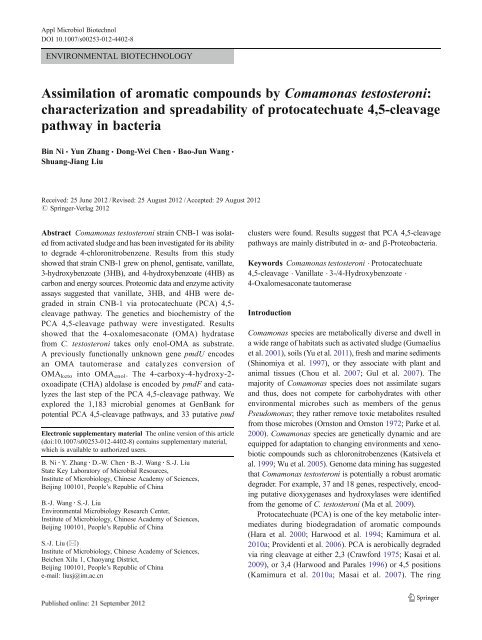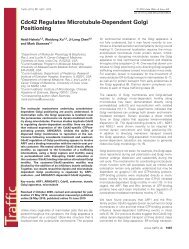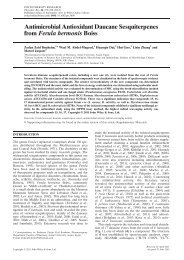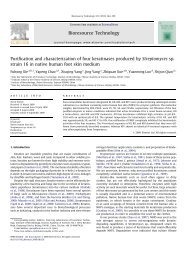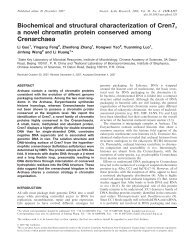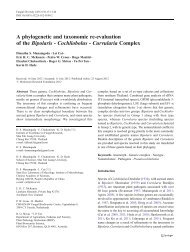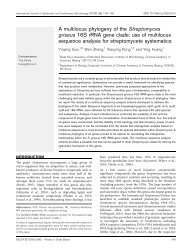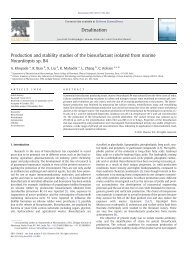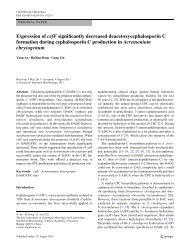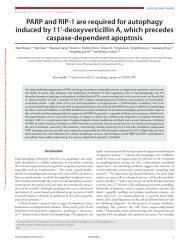characterization and spreadability of protocatechuate 4,5-cleavage
characterization and spreadability of protocatechuate 4,5-cleavage
characterization and spreadability of protocatechuate 4,5-cleavage
You also want an ePaper? Increase the reach of your titles
YUMPU automatically turns print PDFs into web optimized ePapers that Google loves.
Appl Microbiol Biotechnol<br />
DOI 10.1007/s00253-012-4402-8<br />
ENVIRONMENTAL BIOTECHNOLOGY<br />
Assimilation <strong>of</strong> aromatic compounds by Comamonas testosteroni:<br />
<strong>characterization</strong> <strong>and</strong> <strong>spreadability</strong> <strong>of</strong> <strong>protocatechuate</strong> 4,5-<strong>cleavage</strong><br />
pathway in bacteria<br />
Bin Ni & Yun Zhang & Dong-Wei Chen & Bao-Jun Wang &<br />
Shuang-Jiang Liu<br />
Received: 25 June 2012 / Revised: 25 August 2012 /Accepted: 29 August 2012<br />
# Springer-Verlag 2012<br />
Abstract Comamonas testosteroni strain CNB-1 was isolated<br />
from activated sludge <strong>and</strong> has been investigated for its ability<br />
to degrade 4-chloronitrobenzene. Results from this study<br />
showed that strain CNB-1 grew on phenol, gentisate, vanillate,<br />
3-hydroxybenzoate (3HB), <strong>and</strong> 4-hydroxybenzoate (4HB) as<br />
carbon <strong>and</strong> energy sources. Proteomic data <strong>and</strong> enzyme activity<br />
assays suggested that vanillate, 3HB, <strong>and</strong> 4HB were degraded<br />
in strain CNB-1 via <strong>protocatechuate</strong> (PCA) 4,5-<br />
<strong>cleavage</strong> pathway. The genetics <strong>and</strong> biochemistry <strong>of</strong> the<br />
PCA 4,5-<strong>cleavage</strong> pathway were investigated. Results<br />
showed that the 4-oxalomesaconate (OMA) hydratase<br />
from C. testosteroni takes only enol-OMA as substrate.<br />
A previously functionally unknown gene pmdU encodes<br />
an OMA tautomerase <strong>and</strong> catalyzes conversion <strong>of</strong><br />
OMA keto into OMA enol . The 4-carboxy-4-hydroxy-2-<br />
oxoadipate (CHA) aldolase is encoded by pmdF <strong>and</strong> catalyzes<br />
the last step <strong>of</strong> the PCA 4,5-<strong>cleavage</strong> pathway. We<br />
explored the 1,183 microbial genomes at GenBank for<br />
potential PCA 4,5-<strong>cleavage</strong> pathways, <strong>and</strong> 33 putative pmd<br />
Electronic supplementary material The online version <strong>of</strong> this article<br />
(doi:10.1007/s00253-012-4402-8) contains supplementary material,<br />
which is available to authorized users.<br />
B. Ni : Y. Zhang : D.-W. Chen : B.-J. Wang : S.-J. Liu<br />
State Key Laboratory <strong>of</strong> Microbial Resources,<br />
Institute <strong>of</strong> Microbiology, Chinese Academy <strong>of</strong> Sciences,<br />
Beijing 100101, People’s Republic <strong>of</strong> China<br />
B.-J. Wang : S.-J. Liu<br />
Environmental Microbiology Research Center,<br />
Institute <strong>of</strong> Microbiology, Chinese Academy <strong>of</strong> Sciences,<br />
Beijing 100101, People’s Republic <strong>of</strong> China<br />
S.-J. Liu (*)<br />
Institute <strong>of</strong> Microbiology, Chinese Academy <strong>of</strong> Sciences,<br />
Beichen Xilu 1, Chaoyang District,<br />
Beijing 100101, People’s Republic <strong>of</strong> China<br />
e-mail: liusj@im.ac.cn<br />
clusters were found. Results suggest that PCA 4,5-<strong>cleavage</strong><br />
pathways are mainly distributed in α- <strong>and</strong>β-Proteobacteria.<br />
Keywords Comamonas testosteroni . Protocatechuate<br />
4,5-<strong>cleavage</strong> . Vanillate . 3-/4-Hydroxybenzoate .<br />
4-Oxalomesaconate tautomerase<br />
Introduction<br />
Comamonas species are metabolically diverse <strong>and</strong> dwell in<br />
a wide range <strong>of</strong> habitats such as activated sludge (Gumaelius<br />
et al. 2001), soils (Yu et al. 2011), fresh <strong>and</strong> marine sediments<br />
(Shinomiya et al. 1997), or they associate with plant <strong>and</strong><br />
animal tissues (Chou et al. 2007; Gul et al. 2007). The<br />
majority <strong>of</strong> Comamonas species does not assimilate sugars<br />
<strong>and</strong> thus, does not compete for carbohydrates with other<br />
environmental microbes such as members <strong>of</strong> the genus<br />
Pseudomonas; they rather remove toxic metabolites resulted<br />
from those microbes (Ornston <strong>and</strong> Ornston 1972; Parke et al.<br />
2000). Comamonas species are genetically dynamic <strong>and</strong> are<br />
equipped for adaptation to changing environments <strong>and</strong> xenobiotic<br />
compounds such as chloronitrobenzenes (Katsivela et<br />
al. 1999;Wuetal.2005). Genome data mining has suggested<br />
that Comamonas testosteroni is potentially a robust aromatic<br />
degrader. For example, 37 <strong>and</strong> 18 genes, respectively, encoding<br />
putative dioxygenases <strong>and</strong> hydroxylases were identified<br />
from the genome <strong>of</strong> C. testosteroni (Ma et al. 2009).<br />
Protocatechuate (PCA) is one <strong>of</strong> the key metabolic intermediates<br />
during biodegradation <strong>of</strong> aromatic compounds<br />
(Hara et al. 2000; Harwood et al. 1994; Kamimura et al.<br />
2010a; Providenti et al. 2006). PCA is aerobically degraded<br />
via ring <strong>cleavage</strong> at either 2,3 (Crawford 1975; Kasai et al.<br />
2009), or 3,4 (Harwood <strong>and</strong> Parales 1996) or 4,5 positions<br />
(Kamimura et al. 2010a; Masai et al. 2007). The ring
Appl Microbiol Biotechnol<br />
<strong>cleavage</strong> at the 4,5 position is catalyzed by PCA 4,5-dioxygenase<br />
(P45D). Various P45Ds have been found in several<br />
bacterial groups such as Comamonas species (Kamimura et<br />
al. 2010a; Mampeletal.2005; Providentietal.2001),<br />
Pseudomonas species (Maruyama et al. 2004), Sphingobium<br />
species (Masai et al. 1999; Wattiau et al. 2001), <strong>and</strong> Delftia<br />
sp. strain TBKNP-05 (Patil et al. 2006). Following PCA<br />
ring <strong>cleavage</strong>, the product 4-carboxy-2-hydroxymuconate-<br />
6-semi-aldehyde (CHMS) is spontaneously converted to its<br />
intramolecular hemiacetal form <strong>and</strong> is sequentially oxidized<br />
into 2-pyrone-4,6-dicarboxylate (PDC) (Hara et al. 2000,<br />
2003; Kamimura et al. 2010a; Maruyama et al. 2004; Masai<br />
et al. 1999, 2000; Providenti et al. 2001; Fig. 1a). PDC is<br />
hydrolyzed into 4-oxalomesaconate (OMA), which then<br />
undergoes hydration to 4-carboxy-4-hydroxy-2-oxoadipate<br />
(CHA). CHA is converted into oxaloacetic <strong>and</strong> pyruvic<br />
acids via aldolic <strong>cleavage</strong> (Hara et al. 2003; Maruyama et<br />
al. 2001; Wang et al. 2010). Although the genes involved in<br />
PCA 4,5-<strong>cleavage</strong> have been investigated extensively in<br />
Sphingobium paucimobilis SYK-6 (Hara et al. 2000, 2003;<br />
Kamimura et al. 2010b; Masai et al. 1999, 2000) <strong>and</strong> in<br />
Pseudomonas (Noda et al. 1990) <strong>and</strong> Comamonas species<br />
(Kamimura et al. 2010a; Mampel et al. 2005; Providenti et<br />
al. 2001), the lower pathway reactions <strong>and</strong> genes involved in<br />
conversion <strong>of</strong> PDC into oxaloacetic <strong>and</strong> pyruvic acids in<br />
Comamonas species are still hypothetical <strong>and</strong> have not been<br />
experimentally identified.<br />
In this report, we present the results <strong>of</strong> assimilation <strong>of</strong><br />
aromatic compounds by C. testosteroni strain CNB-1 grown<br />
on phenol, gentisate, vanillate, 3-hydroxybenzoate (3HB),<br />
<strong>and</strong> 4-hydroxybenzoate (4HB). Vanillate, 3HB, <strong>and</strong> 4HB<br />
were degraded via PCA 4,5-<strong>cleavage</strong> pathway. A previously<br />
hypothetical gene pmdU with unknown function was characterized<br />
to be an OMA tautomerase <strong>and</strong> catalyzes the<br />
conversion <strong>of</strong> OMA keto into OMA enol . The <strong>spreadability</strong> <strong>of</strong><br />
PCA 4,5-<strong>cleavage</strong> pathway in bacteria was explored via data<br />
mining <strong>of</strong> microbial genomes.<br />
Material <strong>and</strong> methods<br />
Bacterial strains, plasmids, <strong>and</strong> cultural conditions<br />
Bacterial strains <strong>and</strong> plasmids used in this study are listed in<br />
Table 1. C. testosteroni strain CNB-2 is a plasmid-curing<br />
derivative from C. testosteroni strain CNB-1 (CGMCC<br />
1.12282;Wu et al. 2005, 2006). Escherichia coli was grown<br />
aerobically on a rotary shaker (200 rpm) at 37 °C in Luria-<br />
Bertani (LB) broth or on LB plate with 1.5 % (w/v) agar. C.<br />
testosteroni strains were cultivated <strong>and</strong> maintained in LB<br />
medium or in minimal salt broth (MSB; Wu et al. 2006)<br />
containing 1 gL −1 ammonium chloride as nitrogen source.<br />
Aromatic compounds were added at final concentrations <strong>of</strong><br />
0.2 gL −1 when they were used as sole carbon <strong>and</strong> energy<br />
sources. Cellular growth was monitored by measuring turbidity<br />
(optical density) at 600 nm. If necessary, antibiotics<br />
were used at the following concentrations: kanamycin,<br />
50 mgL −1 for E. coli <strong>and</strong> 150 mgL −1 for strain CNB-1;<br />
tetracycline, 20 mgL −1 for both E. coli <strong>and</strong> strain CNB-1.<br />
Comparative proteomic analysis<br />
Comparative proteomic studies were conducted as previously<br />
described (Zhang et al. 2009). In brief, cells<br />
were harvested at the late exponential phase <strong>of</strong> growth<br />
<strong>and</strong> were broken by sonication on ice. Supernatant <strong>of</strong><br />
cellular lysate (ca. 300 μg proteins) were analyzed by<br />
2-DE. IEF <strong>and</strong> SDS-PAGE were operated at the same<br />
conditions as described previously (Zhang et al. 2009).<br />
Proteins were digested with trypsin <strong>and</strong> the resulting<br />
peptides were detected by mass spectrometry. Protein<br />
identification was carried out according to their peptide<br />
fingerprints. A two-tailed Student's t test was adopted to<br />
evaluate the spot differences between the control <strong>and</strong><br />
experimental gels (P
Appl Microbiol Biotechnol<br />
Fig. 1 The degradation <strong>of</strong> vanillate, 3-, <strong>and</strong> 4-hydroxybenzoate in<br />
Comamonas testosteroni CNB-1 (a) <strong>and</strong> gene clusters <strong>of</strong> <strong>protocatechuate</strong><br />
4,5-<strong>cleavage</strong> pathway in strain CNB-1 <strong>and</strong> other bacterial strains<br />
(b). In a, proteins shown in bold indicates that proteins were detected<br />
from proteomes <strong>of</strong> strain CNB-1 grown on vanillate, 3HB, or 4HB. In<br />
b, species shown in bold indicate the gene cluster was identified<br />
experimentally. The numbers in the brackets indicate the strains found<br />
in the species. Abbreviations: for enzymes: PmdA protocatachuate 4,5-<br />
dioxygenase α-subunit, PmdB protocatachuate 4,5-dioxygenase β-<br />
subunit, PmdC 4-carboxy-2-hydroxymuconate-6-semialdehyde dehydrogenase,<br />
PmdD PDC hydrolase, PmdU 4-oxalomesaconate tautomerase,<br />
PmdE 4-oxalomesaconate hydratase, PmdF 4-carboxy-4-<br />
hydroxy-2-oxoadipate aldolase/oxaloacetate decarboxylase. For compounds:<br />
4HB 4-hydroxybenzoate, PCA <strong>protocatechuate</strong>, CHMS 4-<br />
carboxy-2-hydroxymuconate-6-semialdehyde, PDC 2-pyrone-4, 6-<br />
dicarboxylate, OMAketo 4-oxalomesaconate keto form, OMAenol 4-<br />
oxalomesaconate enol form, CHA 4-carboxy-4-hydroxy-2-oxoadipate<br />
Various derivative plasmids from these vectors were constructed,<br />
<strong>and</strong> their relevant characteristics are listed in<br />
Table 1. Plasmids were electroporated into CNB-1 <strong>and</strong> the<br />
mutants were screened according to Schäfer et al. (1994),<br />
except that LB medium supplemented with a final sucrose<br />
concentration <strong>of</strong> 20 % was used for selection. The deletion
Appl Microbiol Biotechnol<br />
Table 1 Bacterial strains <strong>and</strong> plasmids used in this study<br />
Strain/plasmid/<br />
oligonucleotide<br />
Description<br />
Sources/<br />
references<br />
Strains<br />
Comamonas testosteroni<br />
CNB-1<br />
Wu et al.<br />
(2005)<br />
CNB-1ΔpmdF A fragment <strong>of</strong> DNA coding for amino acids 105 to 215 <strong>of</strong> pmdF was deleted This study<br />
CNB-1ΔpmdF/<br />
This study<br />
pBBR1MCS3-pmdF<br />
CNB-1ΔpmdE A fragment <strong>of</strong> DNA coding for amino acids 32 to 296 <strong>of</strong> pmdE was deleted This study<br />
CNB-1ΔpmdE/<br />
This study<br />
pBBR1MCS2-pmdE<br />
CNB-1ΔpmdE/<br />
This study<br />
pBBR1MCS2-galB<br />
CNB-1ΔpmdU A fragment <strong>of</strong> DNA coding for amino acids 6 to 226 <strong>of</strong> pmdU was deleted This study<br />
CNB-1ΔpmdU/<br />
This study<br />
pBBR1MCS2-pmdU<br />
CNB-1ΔpmdU/<br />
This study<br />
pBBR1MCS2-galD<br />
E. coli strains This study<br />
BL21(DE3)<br />
F − ompT hsdSB(rB − mB − ) gal dcm λDE3 (harboring gene 1 <strong>of</strong> the RNA polymerase from the<br />
phage T7 under the PlacUV5 promoter)<br />
Maniatis et al.<br />
(1982)<br />
DH5α (f80lacZΔM15)endA1 recA1 hsdR17 (rK − mK − ) supE44ΔlacU169 Maniatis et al.<br />
(1982)<br />
Pseudomonas putida<br />
KT2440<br />
Plasmid<br />
Franklin et al.<br />
(1981)<br />
pK18mobSacB Mobilizable vector, allows for selection <strong>of</strong> double crossover in CNB-1 Schäfer et al.<br />
(1994)<br />
pK18mobSacB-ΔpmdE<br />
pK18mobSacB-ΔpmdU<br />
pK18mobSacB-ΔpmdF<br />
pBBR1MCS3 Tc r , lacPOZ′ broad host vector with R type conjugative origin Kovach et al.<br />
(1995)<br />
pBBR1MCS2 Km r , lacPOZ′ broad host vector with R type conjugative origin Kovach et al.<br />
(1995)<br />
pBBR1MCS3-pmdF Carrying pmdF (to generate complementation for pmdF) This study<br />
pBBR1MCS2-pmdE Carrying pmdE (to generate complementation for pmdE) This study<br />
pBBR1MCS2-pmdU Carrying pmdU (to generate complementation for pmdU) This study<br />
pBBR1MCS2-galD Carrying galD (to generate expression for galD) This study<br />
pBBR1MCS2-galB Carrying galB (to generate expression for galB) This study<br />
pET-28a(+) Expression vector Novagen<br />
pET-28a-pmdAB pET28a derivative for expression <strong>of</strong> pmdAB This study<br />
pET-28a-pmdU pET28a derivative for expression <strong>of</strong> pmdU This study<br />
pET-28a-pmdE pET28a derivative for expression <strong>of</strong> pmdE This study<br />
pET-28a-pmdF pET28a derivative for expression <strong>of</strong> pmdF This study<br />
pET-28a-galB pET28a derivative for expression <strong>of</strong> galB This study<br />
pET-28a-galD pET28a derivative for expression <strong>of</strong> galD This study<br />
<strong>of</strong> the target genes in pK18mobsacB derivatives <strong>and</strong> in<br />
CNB-1 mutants were verified by PCR amplification. The<br />
complementation <strong>of</strong> these genes was conducted by introducing<br />
pBBR1MCS2 or pBBR1MCS3 derivatives into the<br />
mutants.<br />
Cloning, expression, <strong>and</strong> purification <strong>of</strong> pmd <strong>and</strong> gal genes<br />
in E. coli<br />
Each gene <strong>of</strong> the pmd gene cluster <strong>of</strong> strain CNB-1 <strong>and</strong> gal<br />
cluster <strong>of</strong> strain KT2440 was amplified by PCR from the
Appl Microbiol Biotechnol<br />
genomes <strong>of</strong> strains CNB-1 <strong>and</strong> KT2440. Purified PCR products<br />
were treated with restriction enzymes <strong>and</strong> then ligated into the<br />
similarly treated pET28a (+). The resulting plasmids were transformed<br />
in E. coli BL21 (DE3) for expression <strong>of</strong> the genes.<br />
Expression <strong>of</strong> the genes in E. coli was induced with 0.1 mM<br />
isopropyl β-D-1-thiogalactopyranoside (IPTG) at 16 °C for 10–<br />
12 h, when the optical density at 600 nm reached 0.6. Cellular<br />
lysates <strong>of</strong> recombinant E. coli were prepared by sonication <strong>of</strong><br />
cell suspensions in 50 mM phosphate buffer (pH 8.0) or in<br />
50 μM Fe(NH 4 ) 2 (SO 4 ) 2 solution when purifying PmdAB or<br />
20 μM ZnSO 4 solution when purifying PmdU <strong>and</strong> GalD.<br />
Sonication was conducted (at 300 W, 3 s, interval <strong>of</strong> 5 s, for<br />
90 cycles). Cell debris was removed by centrifugation at<br />
12,000 rpm for 20 min, <strong>and</strong> the supernatant was used for further<br />
purification. Proteins were purified with His-affinity resin chromatography<br />
by following the instruction from the manufacturers<br />
(Novagen).<br />
Enzymatic synthesis <strong>of</strong> OMA keto , OMA enol , <strong>and</strong> CHA<br />
OMA keto ,OMA enol , <strong>and</strong> CHA were prepared as previously<br />
described (Nogales et al. 2011) with the following modification.<br />
OMA keto was freshly prepared from gallic acid in a<br />
system containing (totally 2 mL): 0.2 mM gallic acid,<br />
50 μM Fe(NH 4 ) 2 (SO 4 ) 2, 24 μg recombinant PmdAB from<br />
E. coli, 50 mM potassium phosphate buffer, pH 7.0. After<br />
incubation at room temperature for 5 min, this mixture solution<br />
was used as the crude OMA keto preparation without any<br />
further purification. OMA enol was prepared by incubating the<br />
freshly prepared OMA keto with GalD <strong>and</strong> 20 μM ZnSO 4 for<br />
5 min. CHA was prepared by adding PmdE or GalB (Nogales<br />
et al. 2011) into the freshly prepared OMA enol solution <strong>and</strong><br />
incubated at room temperature for another 5 min.<br />
Enzyme activity assays<br />
The OMA hydratase activity <strong>of</strong> PmdE was assayed spectrophotometrically<br />
at room temperature by measuring the decrease <strong>of</strong><br />
A 265 due to the disappearance <strong>of</strong> OMA enol (Nogales et al. 2011).<br />
The OMA tautomerase activity <strong>of</strong> PmdU was qualitatively<br />
determined at room temperature by adding 0.8 μg purified<br />
PmdU in the 2.0 mL freshly prepared OMA keto .WhenPmdU<br />
was added in the system, an increase in the absorbance at<br />
265 nm can be observed. The CHA aldolase activity <strong>of</strong> PmdF<br />
was assayed at room temperature by monitoring the decrease in<br />
A 340 derived from NADH oxidation in a coupled assay by<br />
adding 1 mM MgSO 4 ,140μM NADH, 30 U lactate dehydrogenase<br />
(Sigma), 30 U malate dehydrogenase (AMRESCO), <strong>and</strong><br />
2.6 μg recombinant PmdF from E. coli (Hara et al. 2003;<br />
Nogales et al. 2011). Catechol 2,3-dioxygenase (C23D) activity<br />
was assayed by monitoring the absorbance changes at 375 nm to<br />
monitor the formation <strong>of</strong> catechol ring <strong>cleavage</strong> product (Cerdan<br />
et al. 1994), <strong>and</strong> PCA P45D activity was determined<br />
spectrophotometrically by measuring the increase in the absorbance<br />
at 410 nm due to the formation <strong>of</strong> 4-carboxy-2-hydroxymuconate-6-semialdehyde<br />
(Kamimura et al. 2010a;Mampelet<br />
al. 2005) <strong>and</strong> gentisate 1,2-dioxygenase (G12D) was measured<br />
spectrophotometrically by measuring the increase <strong>of</strong> absorption<br />
at 330 nm derived from maleylpyruvate (Shen et al. 2005).<br />
Results<br />
C. testosteroni strain CNB-1 grew on various aromatic<br />
compounds<br />
Strain CNB-1 had been isolated for 4CNB degradation, <strong>and</strong> it<br />
takes 4CNB as sole carbon <strong>and</strong> nitrogen sources (Wu et al.<br />
2005). Previous results showed that CNB-2 grew on benzoate,<br />
phenol, 3- <strong>and</strong> 4HB, PCA, <strong>and</strong> vanillate (Ma et al. 2009). In<br />
this study, the ability <strong>of</strong> strain CNB-1 (the parent <strong>of</strong> strain<br />
CNB-2) to grow on a range <strong>of</strong> aromatic compounds was<br />
tested. Results showed that CNB-1 also grew on the following<br />
aromatic compounds, including phenol, benzoate, 3HB, 4HB,<br />
vanillate, <strong>and</strong> gentisate, but not on 4-cresol, 2,4-dihydroxybenzoate,<br />
resorcinol, <strong>and</strong> phenylacetate. Further, aromatic ring<br />
<strong>cleavage</strong> dioxygenase activities were determined. It was found<br />
that C23D activity was associated with cells grown on phenol.<br />
P45D activity was associated with cells grown on vanillate,<br />
3HB, <strong>and</strong> 4HB. G12D activity was associated with cells<br />
grown on gentisate, benzoate, <strong>and</strong> 3HB (Table 2). These<br />
results suggested that strain CNB-1 possessed multiple degradative<br />
pathways for various aromatic compounds.<br />
Identification <strong>of</strong> proteins involving in vanillate, 3HB,<br />
<strong>and</strong> 4HB degradation<br />
In order to identify enzymes/proteins involved in the degradation<br />
<strong>of</strong> these compounds, comparative proteomic analyses<br />
were carried out on CNB-1 cells grown with vanillate, 3HB,<br />
or 4HB versus cells grown with succinate. With cells grown<br />
on vanillate, 3HB, <strong>and</strong> 4HB, 704±5, 705±12, <strong>and</strong> 692±17<br />
spots were recognized, respectively (Supplementary Fig.<br />
S1). Compared with cells grown on succinate, 40 proteins<br />
in total were differently synthesized, <strong>of</strong> which 30 were<br />
induced <strong>and</strong> ten were upregulated. Thirty-seven out <strong>of</strong> the<br />
40 protein spots were successfully identified with MALDI-<br />
TOF mass spectrometry (Table 3).<br />
Most <strong>of</strong> the identified proteins were functionally related<br />
to degradation <strong>of</strong> vanillate, 3HB, <strong>and</strong> 4HB. They are either<br />
involved in the peripheral routes leading to PCA or involved<br />
in the PCA 4,5-<strong>cleavage</strong> pathway (Fig. 1a). The following<br />
enzymes involved in the peripheral routes were detected:<br />
vanillate monooxygenase (V2 <strong>and</strong> V3) <strong>and</strong> vanillate O-<br />
demethylase subunit (V5), 4HB-3-hydroxylase (O3 <strong>and</strong><br />
O4), <strong>and</strong> 3HB hydroxylase (M1). Four enzymes <strong>of</strong> the
Appl Microbiol Biotechnol<br />
Table 2 Assimilation <strong>of</strong> various<br />
aromatic compounds <strong>and</strong> determination<br />
<strong>of</strong> ring <strong>cleavage</strong> activities<br />
in strain CNB-1<br />
+ indicates the enzymatic activity<br />
was positive; − indicates the<br />
enzymatic activity was negative<br />
C23D catechol 2,3-dioxygenase,<br />
P45D <strong>protocatechuate</strong> 4,5-dioxygenase,<br />
G12D genticsate 1,2-<br />
dioxygenase, n.d. enzymatic activity<br />
was not detected<br />
Aromatic compounds Growth (OD 600 ) Dioxygenase activities<br />
At 0 h At 24 h C23D P45D G12D<br />
Resorcinol 0.02 0.09 n.d. n.d. n.d.<br />
2,4-Dihydroxybenzoate 0.03 0.10 n.d. n.d. n.d.<br />
4-Cresol 0.05 0.11 n.d. n.d. n.d.<br />
Phenylacetate 0.04 0.09 n.d. n.d. n.d.<br />
Phenol 0.05 0.47 + − −<br />
Benzoate 0.03 0.30 − − +<br />
3-Hydroxybenzoate 0.04 0.46 − + +<br />
4-Hydroxybenzoate 0.03 0.41 − + −<br />
Vanillate 0.02 0.36 − + −<br />
Gentisate 0.05 0.43 − − +<br />
PCA 4,5-<strong>cleavage</strong> pathway were detected. They were PmdA<br />
(V13/O12/M10), PmdD (V7/O10/M5), PmdF (V9/O6/M7),<br />
<strong>and</strong> PmdE (V6/O9/M3). A functionally unknown protein<br />
<strong>and</strong> putatively involving in PCA degradation, PmdU (V11/<br />
O5/M2), was also detected. In addition, a LysR-type transcriptional<br />
regulator (V8/O8/M4) was induced when vanillate,<br />
3HB, <strong>and</strong> 4HB were used as carbon sources for growth.<br />
Based on the proteomic data, it was deduced that vanillate,<br />
3HB, <strong>and</strong> 4HB were degraded via a common PCA 4,5-<br />
<strong>cleavage</strong> pathway <strong>and</strong> this pathway was likely to be regulated<br />
by the putative LysR-type transcriptional regulator.<br />
Annotation <strong>of</strong> genes involved in PCA 4,5-<strong>cleavage</strong> pathway<br />
from the genome <strong>of</strong> C. testosteroni<br />
In silico analysis <strong>of</strong> the C. testosteroni CNB-2 genome (Ma<br />
et al. 2009) revealed a gene cluster (pmd) that is potentially<br />
involved in PCA 4,5-<strong>cleavage</strong> pathway (Fig. 1b). This pmd cluster<br />
carries genes putatively encoding P45D (CtCNB1_2741-2742/<br />
PmdAB), CHMS dehydrogenase (CtCNB1_2740/PmdC), PDC<br />
hydrolase (CtCNB1_2743/PmdD), OMA hydratase<br />
(CtCNB1_2745/PmdE), CHA aldolase/oxaloacetate decarboxylase<br />
(CtCNB1_2744/PmdF), transporter (CtCNB1_2746/PmdK),<br />
<strong>and</strong> a hypothetical protein (CtCNB1_2747/PmdU) orthologous to<br />
the functionally unknown PmdU <strong>of</strong> Comamonas sp. strain E6.<br />
Results from bioinformatic analysis on these genes are listed in<br />
Supplementary Table S2. Except PmdB, PmdC, <strong>and</strong> the putative<br />
transporter PmdK, all the other translational products from these<br />
genes were detected from the proteomes <strong>of</strong> cells grown on vanillate,3HB,<strong>and</strong>4HB.<br />
Genetic identification <strong>of</strong> the genes involved<br />
in PCA 4,5-<strong>cleavage</strong> pathway in strain CNB-1<br />
To further identify if these genes were involved in PCA 4,5-<br />
<strong>cleavage</strong> pathway, pmdE, pmdF, <strong>and</strong> pmdU were knocked<br />
out. The three resulting mutants lost the ability to grow on<br />
vanillate, 3HB, <strong>and</strong> 4HB as carbon sources. This ability to<br />
grow on vanillate, 3HB, <strong>and</strong> 4HB was restored by genetic<br />
complementation (Fig. 2). All these results indicated that<br />
pmdE, pmdF, <strong>and</strong> pmdU were involved in PCA 4,5-<strong>cleavage</strong><br />
pathway <strong>and</strong> are essential to vanillate, 3HB, <strong>and</strong> 4HB assimilation<br />
with strain CNB-1.<br />
PmdE is an OMA hydratase <strong>and</strong> takes OMA enol<br />
as its substrate<br />
PmdE had 63 % identity to a previously identified OMA<br />
hydratase (LigJ) from S. paucimobilis that was proposed to<br />
take the keto form <strong>of</strong> OMA, i.e., OMA keto , as substrate (Hara<br />
et al. 2000). PmdE also showed 12 % identity to GalB, a<br />
previously characterized OMA hydratase from P. putida that<br />
took enol form <strong>of</strong> OMA, i.e., OMA enol , as substrate (Nogales<br />
et al. 2011). In order to determine the catalytic stereochemistry<br />
<strong>of</strong> PmdE, OMA keto <strong>and</strong> OMA enol were prepared enzymatically<br />
in this study. The hydratase activity <strong>of</strong> PmdE towards<br />
OMA keto or OMA enol was determined. Results showed that<br />
the purified PmdE catalyzed the conversion <strong>of</strong> OMA enol ,but<br />
not OMA keto , into CHA (Fig. 3a <strong>and</strong> b). Thus, it was concluded<br />
that the substrate <strong>of</strong> PmdE was OMA enol , not OMA keto .<br />
This conclusion is also supported by the observation that galB<br />
from P. putida partially restored the phenotype <strong>of</strong> CNB-<br />
1ΔpmdE to grow on 4HB (Fig. 2b).<br />
PmdU is an OMA tautomerase that catalyzes OMA keto<br />
to OMA enol<br />
As the PmdE in strain CNB-1 took OMA enol for substrate,<br />
an enzyme that catalyzes the conversion <strong>of</strong> OMA keto into<br />
OMA enol would be needed. A tautomerase that converts<br />
OMA enol into OMA keto was proposed for Comamonas sp.<br />
strain E6, but had not been experimentally confirmed<br />
(Kamimura et al. 2010a). In this study, we observed that<br />
galD, encoding a tautomerase that converts OMA keto into
Appl Microbiol Biotechnol<br />
Table 3 Proteins differentially expressed in cells grown with vanillate, 3-, or 4-hydroxybenzoate compared to that from succinate<br />
Number orf Protein names/putative function Score Match Coverage pI/<br />
MW (T)<br />
pI/<br />
MW (E)<br />
P<br />
value<br />
Ratio<br />
V1 CtCNB1_0452 FlgL/flagellin <strong>and</strong> related hook-associated<br />
proteins<br />
147 29 69 % 5.04/<br />
41<br />
V2 CtCNB1_4192 VanA2/vanillate monooxygenase 100 19 48 % 5.05/<br />
40<br />
V3 CtCNB1_4192 VanA2/vanillate monooxygenase 101 20 48 % 5.05/<br />
40<br />
V4 CtCNB1_1380 TtdA/tartrate dehydratase alpha subunit/ 52 9 18 % 6.04/<br />
fumarate hydratase class I N-terminal domain<br />
56<br />
V5 CtCNB1_4189 VanA1/vanillate O-demethylase oxygenase 55 19 40 % 5.87/<br />
subunit<br />
40<br />
V6 a CtCNB1_2745 PmdE/putative 4-oxalomesaconate hydratase<br />
76 20 40 % 5.81/<br />
38<br />
V7 a CtCNB1_2743 PmdD/putative 2-pyrone-4,6-dicarboxylic 78 15 49 % 6.06/<br />
acid hydrolase<br />
34<br />
V8 a CtCNB1_2864 LysR/transcriptional regulator 53 13 42 % 6.43/<br />
35<br />
V9 a CtCNB1_2744 PmdF/4-hydroxy-4-methyl-2-oxoglutarate 59 15 45 % 5.78/<br />
aldolase<br />
24<br />
V10 a CtCNB1_2820 SodA/superoxide dismutase 66 9 47 % 6.11/<br />
25<br />
V11 a CtCNB1_2747 PmdU/OMA keto-enol tautomerase 109 11 59 % 4.95/<br />
23<br />
V13 a CtCNB1_2742 PmdA/<strong>protocatechuate</strong> 4,5-dioxygenase 66 15 68 % 5.27/<br />
alpha subunit<br />
17<br />
V14 CtCNB1_3292 Ndk/nucleoside diphosphate kinase 64 7 27 % 5.91/<br />
15<br />
V15 a CtCNB1_2844 UspA/universal stress protein UspA <strong>and</strong> 79 11 62 % 6.28/<br />
related nucleotide-binding proteins<br />
16<br />
O1 CtCNB1_1128 Eno/enolase 71 10 32 % 4.88/<br />
46<br />
O2 CtCNB1_2183 KatG/catalase 162 36 46 % 5.61/<br />
80<br />
O3 CtCNB1_2156 PobA1/4-hydroxybenzoate 3-hydroxylase 91 20 59 % 5.50/<br />
44<br />
O4 CtCNB1_2156 PobA1/4-hydroxybenzoate 3-hydroxylase 100 14 29 % 5.50/<br />
44<br />
M1 CtCNB1_3410 MobA/m-hydroxybenzoate hydroxylase 193 39 66 % 5.69/<br />
70<br />
M6 CtCNB1_2778 GodA/gentisate 1,2-dioxygenase 52 16 42 % 6.10/<br />
42<br />
M9 CtCNB1_2779 Fah/fumarylacetoacetate (FAA) hydrolase 77 12 58 % 5.31/<br />
26<br />
5.08/<br />
45<br />
5.15/<br />
40<br />
5.21/<br />
40<br />
6.38/<br />
64<br />
6.27/<br />
49<br />
6.23/<br />
38<br />
6.56/<br />
36<br />
5.78/<br />
28<br />
6.06/<br />
25<br />
6.12/<br />
21<br />
5.00/<br />
23<br />
5.30/<br />
17<br />
6.36/<br />
16<br />
6.48/<br />
15<br />
4.92/<br />
52<br />
5.95/<br />
78<br />
5.78/<br />
53<br />
5.79/<br />
50<br />
5.96/<br />
72<br />
6.42/<br />
48<br />
5.47/<br />
27<br />
0.000 −3.22<br />
+ +<br />
+ +<br />
+ +<br />
+ +<br />
+ +<br />
+ +<br />
+ +<br />
+ +<br />
0.000 2.39<br />
+ +<br />
+ +<br />
0.000 8.52<br />
+ +<br />
0.010 2.01<br />
0.000 3.55<br />
+ +<br />
+ +<br />
+ +<br />
+ +<br />
+ +<br />
V1–V15 spots from cells grown on vanillate as sole carbon source, O1–O13 spots from cells grown on 4HB as sole carbon source, M1–M11 spots<br />
from cells grown on 3HB as sole carbon source, Score the Mascot protein score among the fractions where the protein was identified, Match the<br />
number <strong>of</strong> spectra matched to the protein, Coverage the protein sequence coverage for the fraction, pI/MW (T) theoretical values from Mascot<br />
search, pI/MW (E) experimental values, P value the change <strong>of</strong> protein is significant (
Appl Microbiol Biotechnol<br />
Fig. 2 Gene disruption <strong>and</strong> complementation <strong>of</strong> pmdE, pmdF, <strong>and</strong><br />
PmdU in C. testosteroni wildtype <strong>and</strong> mutants. Vanillate, 3-, <strong>and</strong> 4-<br />
hydroxybenzoate were used as carbon sources, <strong>and</strong> the phenotypes<br />
were the same. Only the data with 4-hydroxybenzoate were showed.<br />
a CNB-1 (filled square), CNB-1ΔpmdU (filled circle), CNB-<br />
1ΔpmdU/pBBR1MCS2-pmdU (filled triangle), <strong>and</strong> CNB-1ΔpmdU/<br />
pBBR1MCS2-galD (filled inverted triangle). b Growth <strong>of</strong> CNB-1<br />
(filled square), CNB-1ΔpmdE (filled circle), CNB-1ΔpmdE/<br />
pBBR1MCS2-pmdE (filled triangle), <strong>and</strong> CNB-1ΔpmdE/<br />
pBBR1MCS2-galB (filled invertedtriangle).c Growth <strong>of</strong> CNB-1<br />
(filled square), CNB-1ΔpmdF (filled circle), <strong>and</strong> CNB-1ΔpmdF/<br />
pBBR1MCS3-pmdF (filled triangle)<br />
the above functionally identified PmdE. When OMA keto<br />
was used as substrate <strong>and</strong> in the presence <strong>of</strong> PmdU <strong>and</strong><br />
PmdE, OMA keto was converted to CHA (Fig. 3c). Combining<br />
the observation that PmdE only took OMA enol as<br />
substrate, it was deduced that PmdU catalyzed the conversion<br />
<strong>of</strong> OMA keto into OMA enol . We further demonstrated<br />
that PmdU directly converted OMA keto into OMA enol<br />
(Fig. 3d). Thus, it was concluded that PmdU is an OMA<br />
Fig. 3 Determination <strong>of</strong> the<br />
stereochemistry <strong>of</strong> PmdE <strong>and</strong><br />
PmdU from C. testosteroni. a<br />
Time-course <strong>of</strong> the enzymatic<br />
activity <strong>of</strong> PmdE using<br />
OMA enol as substrate. b Timecourse<br />
<strong>of</strong> the enzymatic activity<br />
<strong>of</strong> PmdE using OMA keto as<br />
substrate. c The conversion <strong>of</strong><br />
OMA keto into CHA by coupling<br />
the catalysis <strong>of</strong> PmdU <strong>and</strong><br />
PmdE. d The conversion <strong>of</strong><br />
OMA keto into OMA enol by<br />
PmdU. Filled circle with<br />
PmdU, filled square without<br />
PmdU, showing the spontaneously<br />
conversion <strong>of</strong> OMA keto<br />
into OMA enol
Appl Microbiol Biotechnol<br />
tautomerase <strong>and</strong> catalyzes the conversion <strong>of</strong> OMA keto into<br />
OMA enol .<br />
PmdF shows both CHA aldolase <strong>and</strong> oxalacetate<br />
decarboxylase activities<br />
The deduced amino acid sequence <strong>of</strong> PmdF showed 98.7 %,<br />
65.1 %, 56.7 %, <strong>and</strong> 55.9 % identities to CHA aldolases<br />
from P. ochraceae (ProA), S. paucimobilis (LigK), P. putida<br />
(HMG), <strong>and</strong> P. putida (GalC), respectively (Hara et al. 2003;<br />
Maruyama et al. 2001; Nogales et al. 2011; Wang et al.<br />
2010). The pmdF gene was cloned <strong>and</strong> expressed in E. coli,<br />
<strong>and</strong> the recombinant PmdF was purified <strong>and</strong> used for enzymatic<br />
activity assays. The PmdF showed obvious aldolase<br />
activity when CHA was used as substrate <strong>and</strong> obvious<br />
decarboxylase activity when oxaloacetate was used as substrate<br />
(Supplementary Fig. S4).<br />
Discussion<br />
Being a key intermediate during biodegradation <strong>of</strong> aromatic<br />
compounds (Harwood et al. 1994; Haraetal.2000), PCA is<br />
aerobically degraded via ring <strong>cleavage</strong> at either 2,3 (Crawford<br />
1975; Kasai et al. 2009), or 3,4 (Harwood <strong>and</strong> Parales 1996)<br />
or 4,5 positions (Kamimura et al. 2010a; Masai et al. 2007). In<br />
order to explore the distribution <strong>of</strong> the PCA 4,5-<strong>cleavage</strong><br />
pathway in various microbial groups, we conducted extensive<br />
searches for putative pmd clusters from currently sequenced<br />
organisms. In silico searches from 1,183 completed microbial<br />
genomes revealed that 33 genomes carry gene clusters orthologous<br />
to pmdBCDEF. About91%<strong>of</strong>thepmd clusters were<br />
found in Proteobacteria (genera Bradyrhizobium, Comamonas,<br />
Delftia, Marinomonas, Novosphingobium, Rhodopseudomonas,<br />
Sphingobium, etc.) <strong>and</strong> the remaining 9 % were<br />
found in Actinobacteria (Arthrobacter <strong>and</strong> Kitasatospora).<br />
Interestingly, seven <strong>of</strong> the 33 microorganisms can colonize<br />
higher plants (Giraud et al. 2007;Krauseetal.2006; Liu et al.<br />
2007a; Lucas-Elio et al. 2011; Rawlings <strong>and</strong> Bateman 2009;<br />
V<strong>and</strong>amme et al. 2002), two can colonize animal (Pinel et al.<br />
2008; Roh et al. 2012), <strong>and</strong> one was in association with marine<br />
algae (Akagawamatsushita et al. 1992).<br />
Two types <strong>of</strong> genetic organization/cluster were recognized<br />
for PCA 4,5-<strong>cleavage</strong> pathway: The Sphingobium-type gene<br />
cluster constitutes several transcriptional units (Hara et al.<br />
2003). The Comamonas–Pseudomonas type constitutes only<br />
one transcriptional unit (Masai et al. 2007). According to our<br />
alignment on the pmd clusters in Fig. 1b, the gene organizations<br />
<strong>of</strong> pmd clusters are more diverse among various bacterial<br />
groups. The positions <strong>of</strong> the putative regulator, the PMA tautomerase,<br />
<strong>and</strong> a functionally unknown gene are apparently localized<br />
differently at the pmd gene clusters among the<br />
Acitinobacteria, α-Proteobacteria, β-Proteobacteria, <strong>and</strong> γ-<br />
Proteobacteria. Thus, we deduce that the transcriptions <strong>of</strong> pmd<br />
genes are also diverse <strong>and</strong> they are controlled by specific<br />
regulators in each bacterial group. In Sphingobium sp. strain<br />
SYK-6, a LysR-type transcriptional regulator, LigR, is responsible<br />
for the activation <strong>of</strong> pmd genes (Kamimura et al. 2010b).<br />
AsshowninFig.1b <strong>and</strong>reportedbyKamimuraetal.(2010b),<br />
there is no putative regulator gene within the pmd cluster <strong>of</strong><br />
Comamonas species. In this study, we found that the expression<br />
level <strong>of</strong> a LysR-type regulator (CtCNB1_2864) was induced<br />
when vanillate, 3HB, or 4HB served as carbon source. It is<br />
deduced that this CtCNB1_2864 is the putative LysR-type<br />
regulator <strong>and</strong> activates the pmd operon in Comamonas species.<br />
C. testosteroni strain CNB-1 has been extensively investigated<br />
for its ability to grow on chloronitrobenze <strong>and</strong> various<br />
aromatic compounds (Liu et al. 2007a, b;Maetal.2007;Wuet<br />
al. 2005, 2006; Zhang et al. 2009). This study further disclosed<br />
that strain CNB-1 adopts a PCA 4,5-<strong>cleavage</strong> for the degradation<br />
<strong>of</strong> vanillate, 3HB, <strong>and</strong> 4HB. The genes involved in this<br />
PCA 4,5-<strong>cleavage</strong> pathway were located at a pmd gene cluster<br />
<strong>and</strong> their translational products were detected in proteomes <strong>of</strong><br />
strain CNB-1 cells grown on vanillate, 3HB, <strong>and</strong> 4HB. Based<br />
on the results obtained from this study, the degradative pathways<br />
for vanillate, 3HB, <strong>and</strong> 4HB were proposed, <strong>and</strong> the central<br />
PCA 4,5-<strong>cleavage</strong> pathway is modified from that proposed for<br />
Comamonas species strain E6 (Kamimura et al. 2010b). This<br />
modified PCA 4,5-<strong>cleavage</strong> pathway in strain CNB-1 includes<br />
tautomerization <strong>and</strong> is similar to the gallic acid degradation<br />
pathway from P. putida (Nogales et al. 2011). Based on our<br />
observation that the genetic organizations <strong>of</strong> pmd clusters are<br />
similar in Comamonas <strong>and</strong> Sphingomonas species, we further<br />
proposed that the PCA 4,5-<strong>cleavage</strong> pathway in C. testosteroni<br />
strainsCNB-1<strong>and</strong>E6<strong>and</strong>inS. paucimobilis SYK-6 should be<br />
the same. This proposal is also supported by the previous results<br />
that the GalB was able to replace the function <strong>of</strong> LigJ in S.<br />
paucimobilis (Nogales et al. 2011).<br />
Acknowledgements This work was supported by a grant from the<br />
National Natural Science Foundation <strong>of</strong> China (31230003).<br />
References<br />
Akagawamatsushita M, Matsuo M, Koga Y, Yamasato K (1992) Alteromonas<br />
atlantica sp. nov. <strong>and</strong> Alteromonas carrageenovora sp.<br />
nov., bacteria that decompose algal polysaccharides. Int J Syst<br />
Bacteriol 42:621–627<br />
Cerdan P, Wasserfallen A, Rekik M, Timmis KN, Harayama S (1994)<br />
Substrate specificity <strong>of</strong> catechol 2,3-dioxygenase encoded by<br />
TOL plasmid pWW0 <strong>of</strong> Pseudomonas putida <strong>and</strong> its relationship<br />
to cell growth. J Bacteriol 176:6074–6081<br />
Chou JH, Sheu SY, Lin KY, Chen WM, Arun AB, Young CC (2007)<br />
Comamonas odontotermitis sp. nov., isolated from the gut <strong>of</strong> the<br />
termite Odontotermes formosanus. Int J Syst Evol Microbiol<br />
57:887–891<br />
Crawford RL (1975) Novel pathway for degradation <strong>of</strong> protocatechuic<br />
acid in Bacillus species. J Bacteriol 121:531–536
Appl Microbiol Biotechnol<br />
Franklin FCH, Bagdasarian M, Bagdasarian MM, Timmis KN (1981)<br />
Molecular <strong>and</strong> functional analysis <strong>of</strong> the TOL plasmid pWWO<br />
from Pseudomonas putida <strong>and</strong> cloning <strong>of</strong> genes for the entire<br />
regulated aromatic ring meta-<strong>cleavage</strong> pathway. Proc Natl Acad<br />
Sci USA 78:7458–7462<br />
Giraud E, Moulin L, Vallenet D, Barbe V, Cytryn E, Avarre JC, Jaubert<br />
M, Simon D, Cartieaux F, Prin Y, Bena G, Hannibal L, Fardoux J,<br />
Kojadinovic M, Vuillet L, Lajus A, Cruveiller S, Rouy Z, Mangenot<br />
S, Segurens B, Dossat C, Franck WL, Chang WS, Saunders E,<br />
Bruce D, Richardson P, Norm<strong>and</strong> P, Dreyfus B, Pignol D, Stacey<br />
G, Emerich D, Vermeglio A, Medigue C, Sadowsky M (2007)<br />
Legumes symbioses: absence <strong>of</strong> Nod genes in photosynthetic bradyrhizobia.<br />
Science 316:1307–1312<br />
Gul M, Ciragil P, Bulbuloglu E, Aral M, Alkis S, Ezberci F (2007)<br />
Comamonas testosteroni bacteremia in a patient with perforated<br />
acute appendicitis. Acta Microbiol Immunol Hung 54:317–321<br />
Gumaelius L, Magnusson G, Pettersson B, Dalhammar G (2001)<br />
Comamonas denitrificans sp. nov., an efficient denitrifying bacterium<br />
isolated from activated sludge. Int J Syst Evol Microbiol<br />
51:999–1006<br />
Hara H, Masai E, Katayama Y, Fukuda M (2000) The 4-<br />
oxalomesaconate hydratase gene, involved in the <strong>protocatechuate</strong><br />
4,5-<strong>cleavage</strong> pathway, is essential to vanillate <strong>and</strong> syringate degradation<br />
in Sphingomonas paucimobilis SYK-6. J Bacteriol<br />
182:6950–6957<br />
Hara H, Masai E, Miyauchi K, Katayama Y, Fukuda M (2003) Characterization<br />
<strong>of</strong> the 4-carboxy-4-hydroxy-2-oxoadipate aldolase<br />
gene <strong>and</strong> operon structure <strong>of</strong> the <strong>protocatechuate</strong> 4,5-<strong>cleavage</strong><br />
pathway genes in Sphingomonas paucimobilis SYK-6. J Bacteriol<br />
185:41–50<br />
Harwood CS, Nichols NN, Kim MK, Ditty JL, Parales RE (1994)<br />
Identification <strong>of</strong> the pcaRKF gene cluster from Pseudomonas<br />
putida: involvement in chemotaxis, biodegradation, <strong>and</strong> transport<br />
<strong>of</strong> 4-hydroxybenzoate. J Bacteriol 176:6479–6488<br />
Harwood CS, Parales RE (1996) The beta-ketoadipate pathway <strong>and</strong> the<br />
biology <strong>of</strong> self-identity. Annu Rev Microbiol 50:553–590<br />
Kamimura N, Aoyama T, Yoshida R, Takahashi K, Kasai D, Abe T,<br />
Mase K, Katayama Y, Fukuda M, Masai E (2010a) Characterization<br />
<strong>of</strong> the <strong>protocatechuate</strong> 4,5-<strong>cleavage</strong> pathway operon in<br />
Comamonas sp. strain E6 <strong>and</strong> discovery <strong>of</strong> a novel pathway gene.<br />
Appl Environ Microb 76:8093–8101<br />
Kamimura N, Kasai D, Senda T, Katayama Y, Fukuda M, Masai E (2010b)<br />
LigR, a LysR-type transcriptional regulator, controls expression <strong>of</strong><br />
the <strong>protocatechuate</strong> 4,5-<strong>cleavage</strong> pathway genes in Sphingobium sp.<br />
strain SYK-6. J Biotechnol 150:236–237 (supplement)<br />
Kasai D, Fujinami T, Abe T, Mase K, Katayama Y, Fukuda M, Masai E<br />
(2009) Uncovering the <strong>protocatechuate</strong> 2,3-<strong>cleavage</strong> pathway<br />
genes. J Bacteriol 191:6758–6768<br />
Katsivela E, Wray V, Pieper DH, Wittich RM (1999) Initial reactions in<br />
the biodegradation <strong>of</strong> 1-chloro-4-nitrobenzene by a newly isolated<br />
bacterium, strain LW1. Appl Environ Microbiol 65:1405–1412<br />
Kovach ME, Elzer PH, Hill DS, Robertson GT, Farris MA, Roop RM,<br />
Peterson KM (1995) 4 new derivatives <strong>of</strong> the broad-Host-range<br />
cloning vector pBBR1MCS, carrying different antibioticresistance<br />
cassettes. Gene 166:175–176<br />
Krause A, Ramakumar A, Bartels D, Battistoni F, Bekel T, Boch<br />
J, Bohm M, Friedrich F, Hurek T, Krause L, Linke B,<br />
McHardy AC, Sarkar A, Schneiker S, Syed AA, Thauer R,<br />
Vorholter FJ, Weidner S, Puhler A, Reinhold-Hurek B, Kaiser<br />
O, Goesmann A (2006) Complete genome <strong>of</strong> the mutualistic,<br />
N 2 -fixing grass endophyte Azoarcus sp. strain BH72. Nat<br />
Biotechnol 24:1385–1391<br />
Liu L, Jiang CY, Liu XY, Wu JF, Han JG, Liu SJ (2007a) Plant–<br />
microbe association for rhizoremediation <strong>of</strong> chloronitroaromatic<br />
pollutants with Comamonas sp. strain CNB-1. Environ Microbiol<br />
9:465–473<br />
Liu L, Wu JF, Ma YF, Wang SY, Zhao GP, Liu SJ (2007b) A novel<br />
deaminase involved in chloronitrobenzene <strong>and</strong> nitrobenzene degradation<br />
with Comamonas sp. strain CNB-1. J Bacteriol<br />
189:2677–2682<br />
Lucas-Elio P, Marco-Noales E, Espinosa E, Ordax M, Lopez MM,<br />
Garcias-Bonet N, Marba N, Duarte CM, Sanchez-Amat A (2011)<br />
Marinomonas alcarazii sp. nov., M. rhizomae sp. nov., M.<br />
foliarum sp. nov., M. posidonica sp. nov. <strong>and</strong> M. aquiplantarum<br />
sp. nov., isolated from the microbiota <strong>of</strong> the seagrass Posidonia<br />
oceanica. Int J Syst Evol Microbiol 61:2191–2196<br />
Ma YF, Wu JF, Wang SY, Jang CY, Zhang Y, Qi SW, Liu L, Zhao GP,<br />
Liu SJ (2007) Nucleotide sequence <strong>of</strong> plasmid pCNB1 from<br />
Comamonas strain CNB-1 reveals novel genetic organization<br />
<strong>and</strong> evolution for 4-chloronitrobenzene degradation. Appl Environ<br />
Microbiol 73:4477–4483<br />
Ma YF, Zhang Y, Zhang JY, Chen DW, Zhu YQ, Zheng HJ, Wang SY,<br />
Jiang CY, Zhao GP, Liu SJ (2009) The complete genome <strong>of</strong><br />
Comamonas testosteroni reveals its genetic adaptations to changing<br />
environments. Appl Environ Microbiol 75:6812–6819<br />
Mampel J, Providenti MA, Cook AM (2005) Protocatechuate 4,5-<br />
dioxygenase from Comamonas testosteroni T-2: biochemical<br />
<strong>and</strong> molecular properties <strong>of</strong> a new subgroup within class III <strong>of</strong><br />
extradiol dioxygenases. Arch Microbiol 183:130–139<br />
Maniatis T, Fritsch EF, Sambrook J (1982) Molecular cloning: a<br />
laboratory manual. Cold Spring Harbor Laboratory, Cold Spring<br />
Harbor<br />
Maruyama K, Miwa M, Tsujii N, Nagai T, Tomita N, Harada T,<br />
Sobajima H, Sugisaki H (2001) Cloning, sequencing, <strong>and</strong> expression<br />
<strong>of</strong> the gene encoding 4-hydroxy-4-methyl-2-oxoglutarate<br />
aldolase from Pseudomonas ochraceae NGJ1. Biosci Biotech<br />
Bioch 65:2701–2709<br />
Maruyama K, Shibayama T, Ichikawa A, Sakou Y, Yamada S, Sugisaki<br />
H (2004) Cloning <strong>and</strong> <strong>characterization</strong> <strong>of</strong> the genes encoding<br />
enzymes for the <strong>protocatechuate</strong> meta-degradation pathway <strong>of</strong><br />
Pseudomonas ochraceae NGJ1. Biosci Biotechnol Biochem<br />
68:1434–1441<br />
Masai E, Katayama Y, Fukuda M (2007) Genetic <strong>and</strong> biochemical<br />
investigations on bacterial catabolic pathways for lignin-derived<br />
aromatic compounds. Biosci Biotechnol Biochem 71:1–15<br />
Masai E, Momose K, Hara H, Nishikawa S, Katayama Y, Fukuda M<br />
(2000) Genetic <strong>and</strong> biochemical <strong>characterization</strong> <strong>of</strong> 4-carboxy-2-<br />
hydroxymuconate-6-semialdehyde dehydrogenase <strong>and</strong> its role in<br />
the <strong>protocatechuate</strong> 4,5-<strong>cleavage</strong> pathway in Sphingomonas<br />
paucimobilis SYK-6. J Bacteriol 182:6651–6658<br />
Masai E, Shinohara S, Hara H, Nishikawa S, Katayama Y, Fukuda M<br />
(1999) Genetic <strong>and</strong> biochemical <strong>characterization</strong> <strong>of</strong> a 2-pyrone-<br />
4,6-dicarboxylic acid hydrolase involved in the <strong>protocatechuate</strong><br />
4,5-<strong>cleavage</strong> pathway <strong>of</strong> Sphingomonas paucimobilis SYK-6. J<br />
Bacteriol 181:55–62<br />
Noda Y, Nishikawa S, Shiozuka K, Kadokura H, Nakajima H,<br />
Yoda K, Katayama Y, Morohoshi N, Haraguchi T, Yamasaki<br />
M (1990) Molecular cloning <strong>of</strong> the <strong>protocatechuate</strong> 4,5-dioxygenase<br />
genes <strong>of</strong> Pseudomonas paucimobilis. J Bacteriol 172:2704–<br />
2709<br />
Nogales J, Canales A, Jimenez-Barbero J, Serra B, Pingarron JM,<br />
Garcia JL, Diaz E (2011) Unravelling the gallic acid degradation<br />
pathway in bacteria: the gal cluster from Pseudomonas putida.<br />
Mol Microbiol 79:359–374<br />
Ornston MK, Ornston LN (1972) Regulation <strong>of</strong> beta-ketoadipate pathway<br />
in Pseudomonas acidovorans <strong>and</strong> Pseudomonas testosteroni.<br />
J Gen Microbiol 73:455–464<br />
Parke D, D'Argenio DA, Ornston LN (2000) Bacteria are not what they<br />
eat: that is why they are so diverse. J Bacteriol 182:257–263<br />
Patil NK, Kundapur R, Shouche YS, Karegoudar TB (2006) Degradation<br />
<strong>of</strong> plasticizer di-n-butylphthalate by Delftia sp. TBKNP-05.<br />
Curr Microbiol 52:369–374
Appl Microbiol Biotechnol<br />
Pinel N, Davidson SK, Stahl DA (2008) Verminephrobacter eiseniae gen.<br />
nov., sp. nov., a nephridial symbiont <strong>of</strong> the earthworm Eisenia<br />
foetida (Savigny). Int J Syst Evol Microbiol 58:2147–2157<br />
Providenti MA, Mampel J, MacSween S, Cook AM, Wyndham RC<br />
(2001) Comamonas testosteroni BR6020 possesses a single genetic<br />
locus for extradiol <strong>cleavage</strong> <strong>of</strong> <strong>protocatechuate</strong>. Microbiology<br />
147:2157–2167<br />
Providenti MA, O'Brien JM, Ruff J, Cook AM, Lambert IB (2006)<br />
Metabolism <strong>of</strong> isovanillate, vanillate, <strong>and</strong> veratrate by Comamonas<br />
testosteroni strain BR6020. J Bacteriol 188:3862–3869<br />
Rawlings ND, Bateman A (2009) Pepsin homologues in bacteria.<br />
BMC Genomics 10:437<br />
Roh H, Yun EJ, Lee S, Ko HJ, Kim S, Kim BY, Song H, Lim KI, Kim<br />
KH, Choi IG (2012) Genome sequence <strong>of</strong> Vibrio sp. strain EJY3,<br />
an agarolytic marine bacterium metabolizing 3,6-anhydro-L-galactose<br />
as a sole carbon source. J Bacteriol 194:2773–2774<br />
Schäfer A, Tauch A, Jäger W, Kalinowski J, Thierbach G, Pühler A<br />
(1994) Small mobilizable multi-purpose cloning vectors derived<br />
from the Escherichia coli plasmids pK18 <strong>and</strong> pK19: selection <strong>of</strong><br />
defined deletions in the chromosome <strong>of</strong> Corynebacterium<br />
glutamicum. Gene 145:69–73<br />
Shen XH, Jiang CY, Huang Y, Liu ZP, Liu SJ (2005) Functional<br />
identification <strong>of</strong> novel genes involved in the glutathioneindependent<br />
gentisate pathway in Corynebacterium glutamicum.<br />
Appl Environ Microbiol 71:3442–3452<br />
Shinomiya M, Iwata T, Kasuya K, Doi Y (1997) Cloning <strong>of</strong> the gene<br />
for poly(3-hydroxybutyric acid) depolymerase <strong>of</strong> Comamonas<br />
testosteroni <strong>and</strong> functional analysis <strong>of</strong> its substrate-binding domain.<br />
FEMS Microbiol Lett 154:89–94<br />
V<strong>and</strong>amme P, Goris J, Chen WM, de Vos P, Willems A (2002)<br />
Burkholderia tuberum sp. nov. <strong>and</strong> Burkholderia phymatum<br />
sp. nov., nodulate the roots <strong>of</strong> tropical legumes. Syst Appl<br />
Microbiol 25:507–512<br />
Wang W, Mazurkewich S, Kimber MS, Seah SY (2010) Structural <strong>and</strong><br />
kinetic <strong>characterization</strong> <strong>of</strong> 4-hydroxy-4-methyl-2-oxoglutarate/4-<br />
carboxy-4-hydroxy-2-oxoadipate aldolase, a <strong>protocatechuate</strong> degradation<br />
enzyme evolutionarily convergent with the HpaI <strong>and</strong><br />
DmpG pyruvate aldolases. J Biol Chem 285:36608–36615<br />
Wattiau P, Bastiaens L, van Herwijnen R, Daal L, Parsons JR, Renard<br />
ME, Springael D, Cornelis GR (2001) Fluorene degradation by<br />
Sphingomonas sp. LB126 proceeds through protocatechuic acid: a<br />
genetic analysis. Res Microbiol 152:861–872<br />
Wu JF, Jiang CY, Wang BJ, Ma YF, Liu ZP, Liu SJ (2006) Novel<br />
partial reductive pathway for 4-chloronitrobenzene <strong>and</strong> nitrobenzene<br />
degradation in Comamonas sp. strain CNB-1. Appl Environ<br />
Microbiol 72:1759–1765<br />
WuJF,SunCW,JiangCY,LiuZP,LiuSJ(2005)Anovel2-<br />
aminophenol 1,6-dioxygenase involved in the degradation <strong>of</strong> p-<br />
chloronitrobenzene by Comamonas strain CNB-1: purification,<br />
properties, genetic cloning <strong>and</strong> expression in Escherichia coli.<br />
Arch Microbiol 183:1–8<br />
Yu XY, Li YF, Zheng JW, Li Y, Li LA, He JA, Li SP (2011) Comamonas<br />
zonglianii sp. nov., isolated from phenol-contaminated soil. Int J<br />
Syst Evol Microbiol 61:255–258<br />
Zhang Y, Wu JF, Zeyer J, Meng B, Liu L, Jiang CY, Liu SQ, Liu SJ<br />
(2009) Proteomic <strong>and</strong> molecular investigation on the physiological<br />
adaptation <strong>of</strong> Comamonas sp. strain CNB-1 growing on 4-<br />
chloronitrobenzene. Biodegradation 20:55–66


